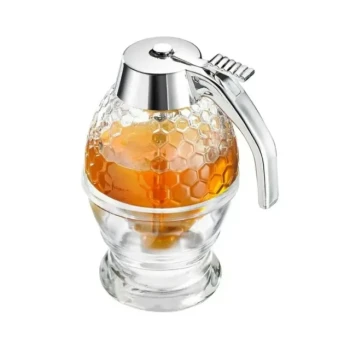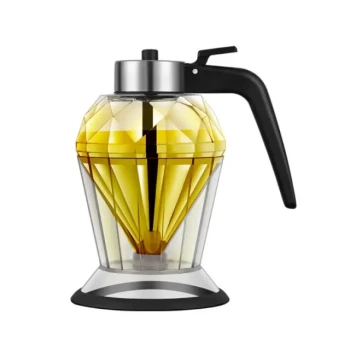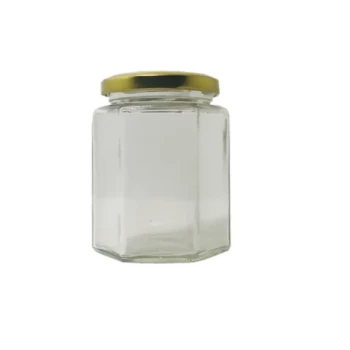The fundamental difference between raw and processed honey lies in human intervention. Raw honey is honey as it exists in the beehive, containing natural pollen and enzymes. Processed honey, in contrast, has been heated and filtered to create a more uniform, shelf-stable product, but this intervention strips it of many beneficial components.
Choosing between raw and processed honey is a direct trade-off. You are deciding between the full spectrum of natural health benefits found in raw honey and the extended shelf life and aesthetic clarity offered by processed honey.
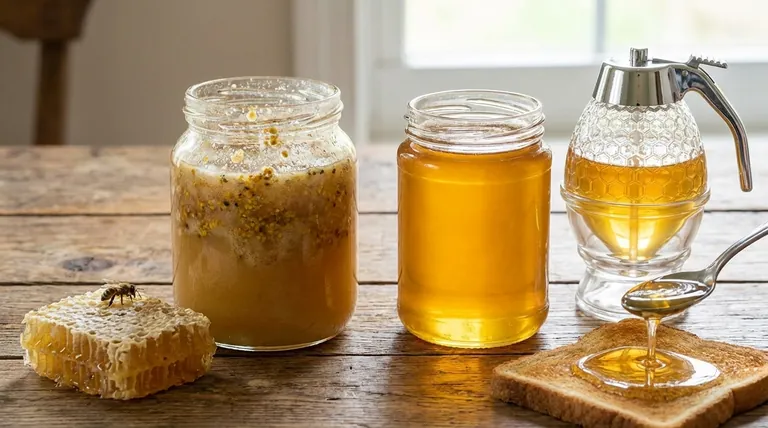
What Defines Raw Honey? The Natural State
Raw honey is essentially honey in its most natural form, taken directly from the honeycomb with minimal processing. It is defined by what it retains.
Retains Natural Components
Raw honey contains bee pollen, propolis, and other tiny solids from the hive. These elements are not impurities; they contribute to the honey's unique flavor profile, texture, and nutritional value.
Unpasteurized and Unfiltered
The key to raw honey is the absence of high heat (pasteurization) and fine filtering. This lack of intervention preserves the delicate enzymes and antioxidants that are naturally present.
The Impact on Flavor and Texture
Because the natural components remain, raw honey offers a richer, more complex, and often more varied flavor. Its color and texture can change from batch to batch depending on the bees' floral source, and it tends to be less clear than processed versions.
What Defines Processed Honey? The Industrial Standard
Processed honey is the clear, uniform product most commonly found on supermarket shelves. It is engineered for consistency and a long shelf life.
The Role of Pasteurization
Most commercial honey is pasteurized—heated to high temperatures. This process destroys yeast cells, preventing fermentation and extending shelf life, but it also degrades or destroys the beneficial enzymes and antioxidants.
The Purpose of Filtering
After heating, the honey is finely filtered. This removes all bee pollen and other small particles, resulting in the perfectly clear, smooth liquid consumers have come to expect.
The Result: Uniformity and Stability
The goal of processing is to create a product that looks the same and resists change over time. This makes it visually appealing and prevents it from crystallizing quickly on the store shelf.
Understanding the Trade-offs: Health vs. Appearance
The decision to process honey has significant consequences, creating a clear divide in quality and purpose.
Nutrient and Enzyme Loss
The primary drawback of processing is the loss of health benefits. The heat from pasteurization neutralizes the natural enzymes and significantly reduces the levels of antioxidants and other heat-sensitive nutrients.
Antibacterial Properties
Raw honey is known for its potent antibacterial properties, partly due to enzymes like glucose oxidase, which produces hydrogen peroxide. Pasteurization deactivates these enzymes, diminishing this natural protective effect.
Crystallization: A Natural Process, Not a Flaw
Raw honey crystallizes more quickly because the pollen particles provide a foundation for sugar crystals to form. This is a natural, reversible process and not a sign of spoilage. Processed honey resists crystallization simply because these particles have been filtered out.
Lower Glycemic Index
Studies suggest raw honey may have a lower glycemic index than processed honey. The natural components help moderate the body's absorption of its sugars, making it a slightly better option for blood sugar management.
Making the Right Choice for Your Goal
Ultimately, neither type of honey is "bad," but they serve different purposes. Your choice should be guided by your primary goal.
- If your primary focus is health and nutritional value: Choose raw, unfiltered honey to get the full benefits of its enzymes, antioxidants, and antibacterial properties.
- If your primary focus is a long shelf life and consistent appearance: Processed honey offers superior stability and will not crystallize as quickly.
- If your primary focus is baking or cooking where clarity is desired: The uniform texture and clarity of processed honey may be more suitable for certain recipes.
Understanding this distinction empowers you to select the honey that aligns perfectly with your needs.
Summary Table:
| Feature | Raw Honey | Processed Honey |
|---|---|---|
| Processing | Unpasteurized, unfiltered | Pasteurized, finely filtered |
| Key Components | Contains natural pollen, enzymes, antioxidants | Pollen and most enzymes removed |
| Appearance/Texture | Cloudy, may crystallize naturally | Clear, smooth, resists crystallization |
| Primary Benefit | Full nutritional and health benefits | Long shelf life, visual consistency |
For commercial apiaries and distributors seeking the highest quality: The choice between raw and processed honey directly impacts your product's value. HONESTBEE supplies the essential beekeeping supplies and equipment needed to produce premium honey, whether your focus is on health-conscious raw honey or stable, commercial-grade processed honey. Let us help you optimize your operation. Contact HONESTBEE today to discuss your wholesale needs.
Visual Guide
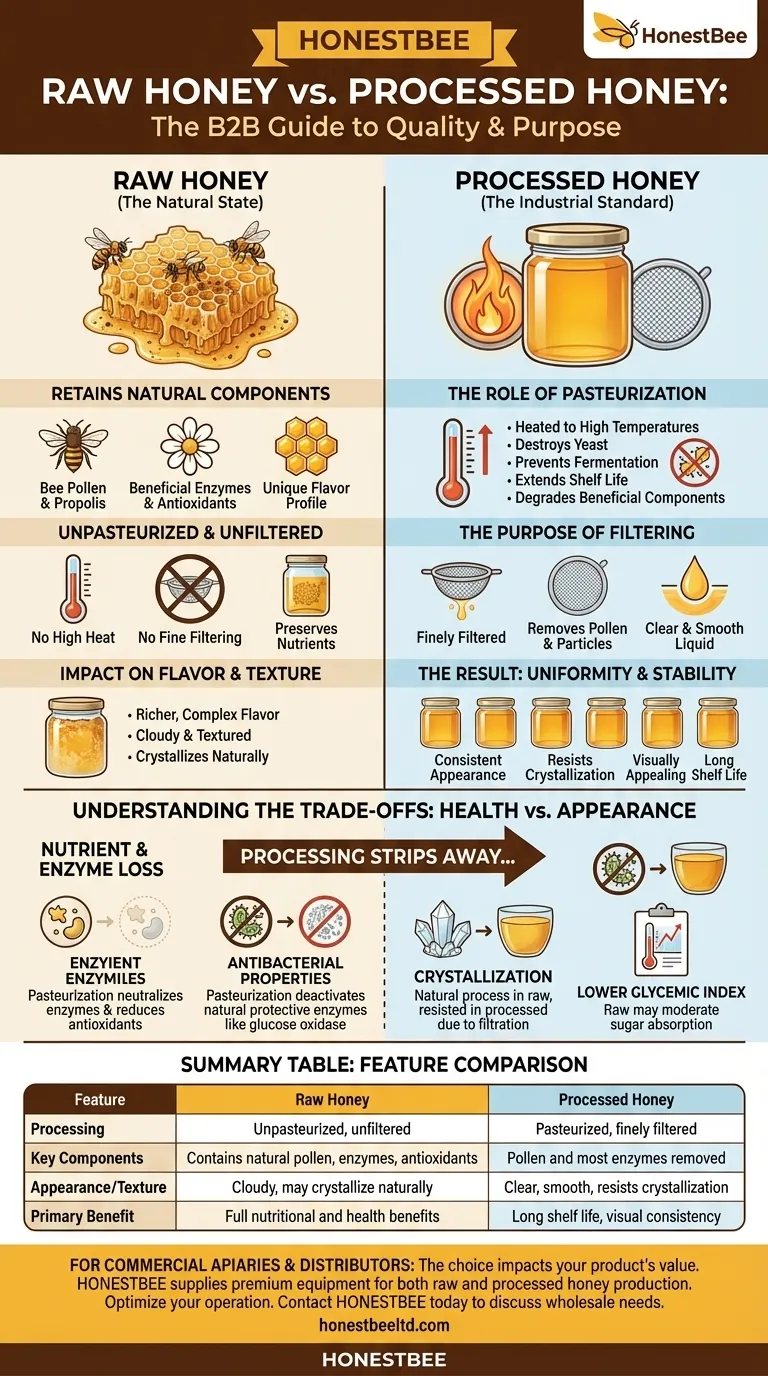
Related Products
- Honeycomb Style Drip Free Honey Dispenser
- Professional Wide Head Honey Uncapping Fork for Beekeeping
- Stainless Steel Honey Press Wax Press with Tank
- Professional Durable Plastic Handle Honey Uncapping Fork
- Extra-Wide All-Stainless Steel Honey Uncapping Fork with T-Handle
People Also Ask
- What is a honey dipper and what is it used for? A Guide to Mess-Free Drizzling
- What is a honey taking spoon called? Discover the Tool for a Perfect, Mess-Free Drizzle
- Can we store honey in a stainless steel container? Yes, with the right food-grade choice.
- Can a honey gate be reused, and how should it be stored? Ensure Longevity for Your Honey Harvests
- What are the benefits of squeeze bottles for honey packaging? Unlock Mess-Free Convenience & Control
